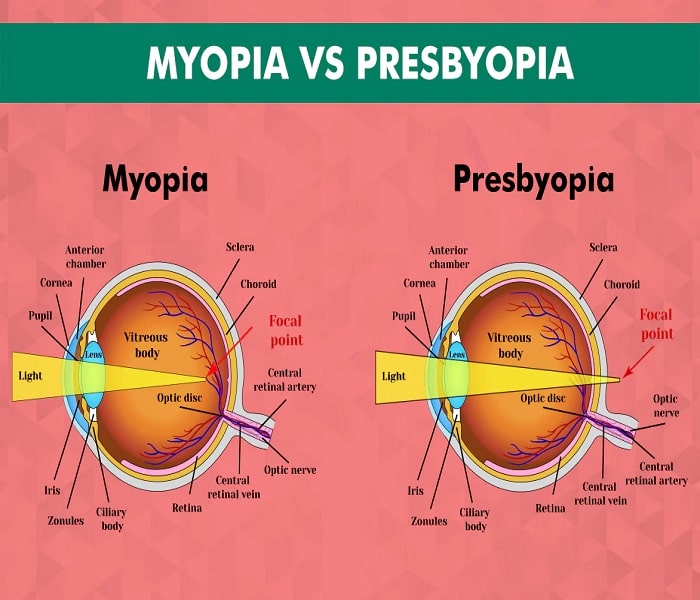Presbyopia
Presbyopia or old eyes is a condition in which the eyes slowly lose their ability to focus quickly on close objects. This condition is something that commonly occurs as we age. Presbyopia generally appears at age 40 and continues to develop until age 65.
This is related to the eye lens which is surrounded by elastic muscles. These muscles can change the shape of the lens to focus light to fall right on the retina. Unfortunately, as we age, the muscles around the eye lens will lose their elasticity and harden. As a result, the eye lens cannot bend light properly to focus it on the retina.
Symptoms of Presbyopia
Symptoms of presbyopia begin to be experienced since someone enters the age of 40 years, usually, someone is not aware that he has presbyopia because he can still try to adjust. You need to recognize the symptoms of presbyopia especially if you are over 40 years old. The symptoms that appear are usually marked by:
- Difficulty reading newspapers or writing on a cell phone or letters from a close distance, and when you move the object away, the writing is more legible.
- Vision becomes blurry when looking at objects at close range.
- Eyes feel sore and head feels tense and sore after reading at close range or writing.
- The above complaints will get worse when you do it in low light conditions.
Risk Factors for Presbyopia
The most significant risk factor for presbyopia is age. Most people lose some of their ability to focus on near objects by age 40. However, certain diseases or medications can cause presbyopia in people younger than 40. When symptoms of presbyopia occur earlier than usual, it is called premature presbyopia. In addition, a person is at higher risk for premature presbyopia if they have:
- Anemia, which is a lack of enough normal blood cells.
- Suffering from cardiovascular disease.
- Diabetes, or difficulty metabolizing blood sugar.
- Having hyperopia, or farsightedness, which means the sufferer has greater difficulty seeing objects that are close up than objects that are far away.
- Multiple sclerosis, which is a chronic disease that affects the spine and brain.
- Myasthenia gravis, which is a neuromuscular disorder that affects the body’s nerves and muscles.
- The presence of trauma or certain eye diseases.
- Have vascular insufficiency, or poor blood flow.
In addition, some prescription and over-the-counter medications can also increase a person’s risk of developing early presbyopia. Examples of these medications are:
- Anti-anxiety medication.
- Antidepressant.
- Antihistamines.
- Antipsychotics.
- Antispasmodic.
- Diuretic.
Causes of Presbyopia
First of all you need to know that in order to see an object, the human eye must capture light, and focus the light from the object being viewed to the retina in the eye. When the object is at a closer distance, the lens of the eye that is responsible for focusing the light captured by the cornea of the eye becomes more flexible.
The lens of the eye is different from the cornea, because the lens of the eye has a flexible nature, and can change shape with the help of the circular muscles that surround it. When you look at an object that is far away, the circular muscles relax. Likewise, when you look at an object at close range, the circular muscles of the eye will tense and make the lens of the eye change shape in order to focus the light received.
In presbyopia, the eye lens will experience changes to become harder and begin to lose its flexibility, this happens with age. As a result of this loss of flexibility, the eye lens becomes difficult to focus the existing light. As a result, the resulting image becomes unfocused/blurry.
Presbyopia Diagnosis
Presbyopia can be diagnosed through a routine eye examination consisting of a vision examination through an eye refraction test, and a complete eye examination.
Presbyopia Treatment
Until now, several steps that can be taken to overcome presbyopia include:
- Wearing glasses.
- Using contact lenses.
- Refractive eye surgery, such as LASIK surgery.
- Eye lens implantation.
- Korean inlay, which is the act of inserting a small plastic ring into each cornea to change the curvature of the cornea.
Complications of Presbyopia
If presbyopia is not diagnosed or not properly corrected, the sufferer’s vision will gradually deteriorate. This condition can make presbyopia sufferers have problems maintaining their daily activity and productivity levels. Especially when sufferers have to read small writings, they can experience headaches and eye fatigue.
Everyone develops presbyopia as they age, so presbyopia may also be accompanied by other types of eye problems. Presbyopia can occur in combination with:
- Astigmatism. An imperfection in the curvature of the cornea that causes blurred vision.
- Hyperopia, or farsightedness.
- Myopia, or nearsightedness.
In addition, people with presbyopia may also have different types of eye problems in each eye.
Presbyopia Prevention
To date, there is no proven technique to prevent presbyopia. However, there are steps you can take to improve your eye health and slow the progression of presbyopia, namely:
- Have regular eye exams.
- Manage chronic health conditions that can cause vision loss, such as diabetes or high blood pressure.
- Wearing sunglasses.
- Wear protective eyewear when participating in activities that may result in eye injury.
- Eat a healthy diet with foods containing antioxidants, vitamin A, and beta carotene.
- Make sure you wear glasses with the right lens size.
- Use good lighting when reading.
When to See a Doctor?
If you experience one or more symptoms of presbyopia, see a doctor immediately. The goal is that appropriate treatment can be carried out early so that the risk of complications can be minimized.

